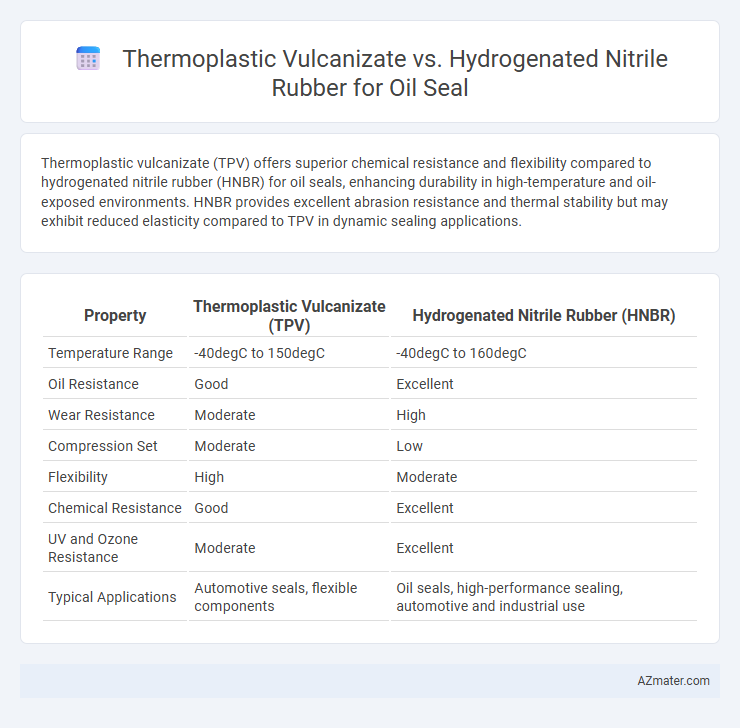Thermoplastic vulcanizate (TPV) offers superior chemical resistance and flexibility compared to hydrogenated nitrile rubber (HNBR) for oil seals, enhancing durability in high-temperature and oil-exposed environments. HNBR provides excellent abrasion resistance and thermal stability but may exhibit reduced elasticity compared to TPV in dynamic sealing applications.
Table of Comparison
| Property | Thermoplastic Vulcanizate (TPV) | Hydrogenated Nitrile Rubber (HNBR) |
|---|---|---|
| Temperature Range | -40degC to 150degC | -40degC to 160degC |
| Oil Resistance | Good | Excellent |
| Wear Resistance | Moderate | High |
| Compression Set | Moderate | Low |
| Flexibility | High | Moderate |
| Chemical Resistance | Good | Excellent |
| UV and Ozone Resistance | Moderate | Excellent |
| Typical Applications | Automotive seals, flexible components | Oil seals, high-performance sealing, automotive and industrial use |
Introduction to Oil Seals and Material Selection
Oil seals are critical components designed to prevent lubricant leakage and contamination in mechanical systems, requiring materials with excellent resistance to oil, heat, and wear. Thermoplastic vulcanizates (TPVs) offer flexibility, chemical resistance, and ease of processing, making them suitable for dynamic sealing applications with moderate temperatures and pressures. Hydrogenated Nitrile Rubber (HNBR) provides superior oil resistance, high temperature tolerance, and abrasion resistance, making it ideal for harsh environments and demanding oil seal performance.
Overview of Thermoplastic Vulcanizate (TPV)
Thermoplastic vulcanizate (TPV) is a highly durable elastomer known for its excellent flexibility, chemical resistance, and thermal stability, making it ideal for oil seal applications exposed to harsh environments. TPV combines the properties of rubber and thermoplastics, allowing for easy processing and recyclability while maintaining strong resistance to oil, heat, and mechanical stress. Compared to hydrogenated nitrile rubber (HNBR), TPV demonstrates superior long-term aging performance and resistance to compression set, ensuring reliable sealing and extended service life in automotive and industrial oil seal applications.
Understanding Hydrogenated Nitrile Rubber (HNBR)
Hydrogenated Nitrile Rubber (HNBR) offers superior resistance to heat, oil, and chemicals compared to standard rubber compounds, making it an ideal material for oil seals in demanding environments. The hydrogenation process significantly enhances HNBR's thermal stability and aging properties, providing extended service life in applications exposed to high temperatures and aggressive fluids. Its compatibility with various automotive and industrial fluids ensures reliable sealing performance and reduced maintenance costs.
Chemical Resistance: TPV vs HNBR in Oil Seals
Thermoplastic vulcanizate (TPV) exhibits moderate chemical resistance to oils, solvents, and fuels, making it suitable for less aggressive oil seal environments. Hydrogenated nitrile rubber (HNBR) offers superior chemical resistance against hydrocarbons, oils, and high-temperature fluids, ensuring extended durability in demanding sealing applications. In oil seals, HNBR outperforms TPV by maintaining integrity and elasticity under prolonged exposure to aggressive chemicals and extreme temperatures.
Mechanical Properties Comparison: Durability and Flexibility
Thermoplastic vulcanizate (TPV) exhibits superior flexibility and excellent fatigue resistance, making it ideal for oil seals subjected to dynamic motion and frequent deformation. Hydrogenated nitrile rubber (HNBR) offers outstanding durability with high tensile strength, excellent abrasion resistance, and superior resistance to heat, oil, and chemicals, ensuring long-term performance in harsh environments. While TPV provides enhanced elastic recovery and flexibility for sealing applications, HNBR delivers greater mechanical strength and wear resistance, making the choice dependent on specific operational demands and environmental exposure.
Temperature Performance for Oil Seal Applications
Thermoplastic vulcanizate (TPV) offers a temperature range typically from -40degC to 150degC, maintaining flexibility and sealing integrity under continuous thermal stress in oil seal applications. Hydrogenated Nitrile Rubber (HNBR) withstands higher temperatures up to 160degC to 180degC, providing superior resistance to heat aging, oil, and chemical exposure in harsh environments. Selecting HNBR ensures enhanced durability and reliability for oil seals operating under extreme temperature conditions compared to TPV.
Processability and Manufacturing Efficiency
Thermoplastic vulcanizate (TPV) offers superior processability compared to hydrogenated nitrile rubber (HNBR) due to its thermoplastic nature, enabling faster injection molding and reduced cycle times in oil seal production. TPV can be re-melted and reprocessed, enhancing manufacturing efficiency and minimizing material waste, while HNBR requires complex curing processes that extend production duration. These factors make TPV a cost-effective choice for high-volume oil seal manufacturing where rapid throughput and consistent quality are critical.
Cost Considerations: TPV vs HNBR
Thermoplastic vulcanizate (TPV) generally offers lower production costs and easier processability compared to hydrogenated nitrile rubber (HNBR), making TPV a cost-effective choice for oil seal manufacturing in high-volume applications. HNBR provides superior chemical resistance and thermal stability but typically demands higher raw material expenses and more complex curing processes, increasing overall production costs. Selecting between TPV and HNBR involves balancing initial material investment with the longevity and performance requirements of the oil seal in specific operating environments.
Typical Applications and Industry Usage
Thermoplastic vulcanizate (TPV) is widely used for oil seals in automotive and industrial machinery due to its excellent elasticity, chemical resistance, and ease of processing. Hydrogenated nitrile rubber (HNBR) offers superior thermal stability, oil resistance, and mechanical strength, making it ideal for heavy-duty applications in aerospace, oil and gas, and hydraulic systems. Both materials serve critical roles in sealing solutions, with TPV favored for cost-effective manufacturing and HNBR chosen for high-performance, high-temperature environments.
Selecting the Right Material for Optimal Oil Seal Performance
Thermoplastic vulcanizate (TPV) offers excellent oil resistance, high flexibility, and ease of processing, making it suitable for dynamic oil seal applications requiring frequent movement and temperature fluctuations up to 150degC. Hydrogenated nitrile rubber (HNBR) excels in chemical resistance, thermal stability up to 160degC, and superior abrasion resistance, ideal for environments with aggressive oils, fuels, and higher temperatures. Selecting the right material depends on the specific operating conditions: TPV suits cost-sensitive applications with moderate temperature and oil exposure, while HNBR is preferred for high-performance seals demanding enhanced durability and resistance to harsh oil-based fluids.

Infographic: Thermoplastic vulcanizate vs Hydrogenated Nitrile Rubber for Oil Seal
 azmater.com
azmater.com